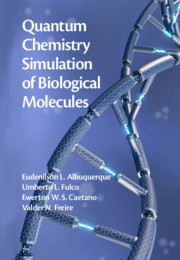Book contents
- Frontmatter
- Contents
- Preface
- Figure Credits
- 1 Basic Properties of Quantum Chemistry
- 2 Charge Transport in the DNA Molecule
- 3 Electronic Transmission Spectra of the DNA Molecule
- 4 Thermodynamic Properties of the DNA Molecule
- 5 Properties of the DNA/RNA Nucleobases
- 6 Molecular Electronics
- 7 Amino Acid Anhydrous Crystals
- 8 Protein–Protein Systems
- 9 Ascorbic Acid and Ibuprofen Drugs
- 10 Cholesterol-Lowering Drugs
- 11 Collagen-Based Biomaterials
- 12 Antimigraine Drugs
- 13 Antiparkinson Drugs
- 14 Central Nervous System Disorders
- 15 The Biology of Cancer
- 16 Concluding Remarks
- Bibliography
- Index
13 - Antiparkinson Drugs
Published online by Cambridge University Press: 21 January 2021
- Frontmatter
- Contents
- Preface
- Figure Credits
- 1 Basic Properties of Quantum Chemistry
- 2 Charge Transport in the DNA Molecule
- 3 Electronic Transmission Spectra of the DNA Molecule
- 4 Thermodynamic Properties of the DNA Molecule
- 5 Properties of the DNA/RNA Nucleobases
- 6 Molecular Electronics
- 7 Amino Acid Anhydrous Crystals
- 8 Protein–Protein Systems
- 9 Ascorbic Acid and Ibuprofen Drugs
- 10 Cholesterol-Lowering Drugs
- 11 Collagen-Based Biomaterials
- 12 Antimigraine Drugs
- 13 Antiparkinson Drugs
- 14 Central Nervous System Disorders
- 15 The Biology of Cancer
- 16 Concluding Remarks
- Bibliography
- Index
Summary
Disorders in the central nervous system have been ascribed to impairments in the function of the AMPA ionotropic glutamate receptors (iGluRs), which are ligand-gated ion channels that undergo structural changes after activation, mediating fast synaptic transmission in the central nervous system. Experimental, computational, and crystallographic analyses have been used to describe partial agonism in AMPA receptors – mainly those related to the willardiines, namely fluorine–willardiine (FW), hydrogen–willardiine (HW), bromine–willardiine (BrW), and iodine–willardiine (IW). By employing quantum chemistry methods based on the density functional theory approach, we unveil here the detailed binding energy features of willardiines co-crystallized with the iGluRs receptors. Our computational results demonstrate that the total binding energies of the AMPA–Willardiines complex correlate with the agonist binding energies, whose experimental sequential data match our computational counterpart, excluding the HW case. Besides, it was observed that FW, BrW, and IW have significant charged states at physiological pH.
Keywords
- Type
- Chapter
- Information
- Quantum Chemistry Simulation of Biological Molecules , pp. 302 - 330Publisher: Cambridge University PressPrint publication year: 2021



